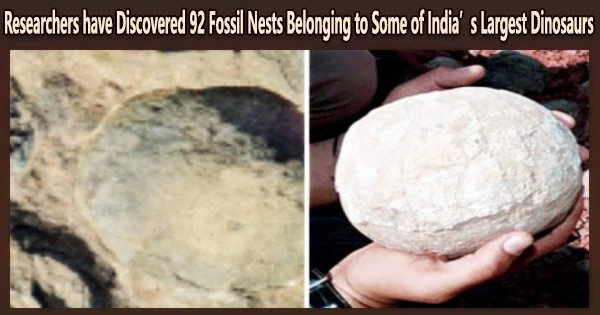According to a study by Harsha Dhiman of the University of Delhi, New Delhi, and colleagues published January 18, 2022 in the open-access journal PLOS ONE, the discovery of more than 250 preserved eggs offers detailed data about the lives of titanosaurs in the Indian subcontinent.
Dinosaur bones and eggs from the Late Cretaceous Period can be found in the Lameta Formation in the Narmada Valley of central India. Titanosaurs were among the largest dinosaurs to have ever existed, and recent investigation in the region discovered 92 nesting sites with a total of 256 fossil eggs belonged to these enormous reptiles.
Detailed examination of these nests has allowed Dhiman and colleagues to make inferences about the life habits of these dinosaurs.
Six separate egg species (oospecies) were identified by the scientists, showing a greater diversity of titanosaurs than is shown by skeletal remains from this area. The team deduced that these dinosaurs hid their eggs in shallow holes like contemporary crocodiles based on the arrangement of the nests.
Pathologies identified in the eggs, including a rare instance of a “egg-in-egg,” suggest that titanosaur sauropods had a reproductive system similar to birds’, and they may have laid their eggs sequentially like modern birds.
Together with dinosaur nests from Jabalpur in the upper Narmada valley in the east and those from Balasinor in the west, the new nesting sites from Dhar District in Madhya Pradesh (Central India), covering an east-west stretch of about 1000 km, constitute one of the largest dinosaur hatcheries in the world.
Guntupalli V.R. Prasad
The presence of many nests in the same area suggests these dinosaurs exhibited colonial nesting behavior like many modern birds. But the close spacing of the nests left little room for adult dinosaurs, supporting the idea that adults left the hatchlings (newborns) to fend for themselves.
Details of dinosaur reproductive habits can be difficult to determine. These dinosaur fossil nests, which date from just before the dinosaur era ended, contain a lot of information on some of the biggest dinosaurs ever. The knowledge gained from this study makes a substantial contribution to paleontologists’ comprehension of the existence and evolution of dinosaurs.
Harsha Dhiman, lead author of the research, adds: “Our research has revealed the presence of an extensive hatchery of titanosaur sauropod dinosaurs in the study area and offers new insights into the conditions of nest preservation and reproductive strategies of titanosaur sauropod dinosaurs just before they went extinct.”
Guntupalli V.R. Prasad, co-author and leader of the research team, adds:
“Together with dinosaur nests from Jabalpur in the upper Narmada valley in the east and those from Balasinor in the west, the new nesting sites from Dhar District in Madhya Pradesh (Central India), covering an east-west stretch of about 1000 km, constitute one of the largest dinosaur hatcheries in the world.”
















